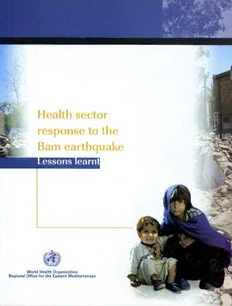
Health Sector Response to the Bam Earthquake: Lessons Learnt (An EMRO Publication) PDF
41 Pages·2005·10.514 MB·English
Most books are stored in the elastic cloud where traffic is expensive. For this reason, we have a limit on daily download.
Preview Health Sector Response to the Bam Earthquake: Lessons Learnt (An EMRO Publication)
Description:
After any major disaster, it is critical to assess the efficiency and effectiveness of humanitarian relief. The delivery of medical supplies, provision of basic medical equipment, and establishment of monitoring systems all require streamlined coordination and collaboration of relief partners. In its support of national authorities, the international community plays a central role in both managing and delivering relief supplies and technical assistance. The earthquake in Bam in 2003 affected more than 50,000 persons living in the area. Many of those injured or killed were health workers, which had a significant impact on the delivery of health services. Humanitarian assistance was mobilized within hours of the earthquake to treat the injured, care for survivors, and bury the dead. After the acute emergency phase, the World Health Organization, in collaboration with the Ministry of Health and Medical Education, Iranian Red Crescent Society, UNICEF, UNFPA and the Iranian Petroleum Industry Health Organization, facilitated a collective exercise whereby all stakeholders discussed and evaluated their inputs to the health sector as part of the overall humanitarian response to the earthquake. This document illustrates the outcomes of the lessons learned exercise.
See more
The list of books you might like
Most books are stored in the elastic cloud where traffic is expensive. For this reason, we have a limit on daily download.
